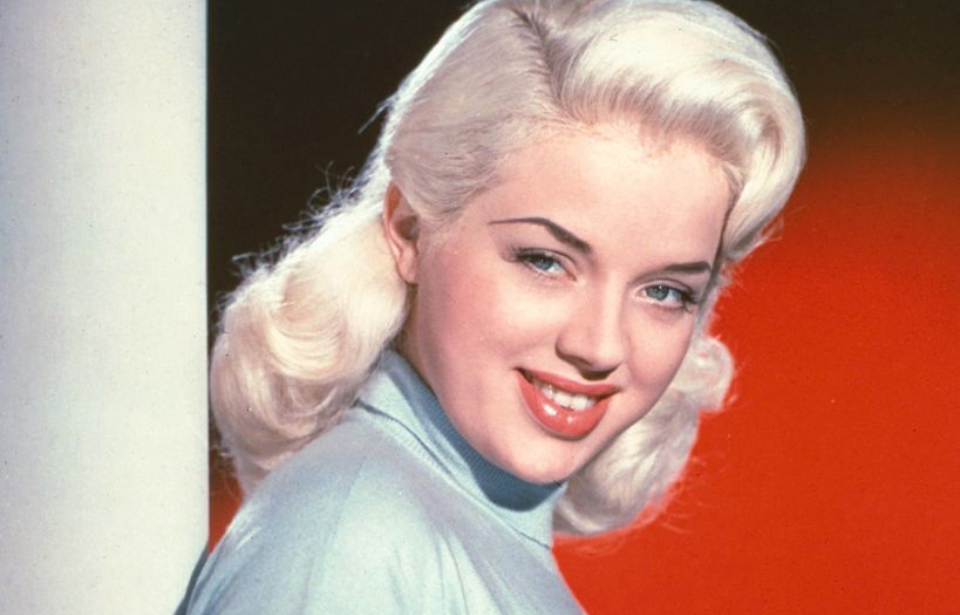When Marilyn Monroe emerged as the ultimate Hollywood bombshell, it was inevitable that other actresses in her orbit would suffer. One of those was British sensation Diana Dors, who was frequently compared to the iconic star. However, Dors’ rise to fame pre-dated that of her American counterpart. For many, she was an icon in her own right.
Like Monroe, she was blonde and beautiful, with a flair for publicity and a quick wit, not to mention acting talent. However, she also had a cultural identity all her own. Talking to Mike Wallace decades ago, the actor proclaimed, “I don’t want to sort of be a carbon copy of Marilyn. I want to be England’s Diana Dors.”
Diana Dors breaks onto the scene
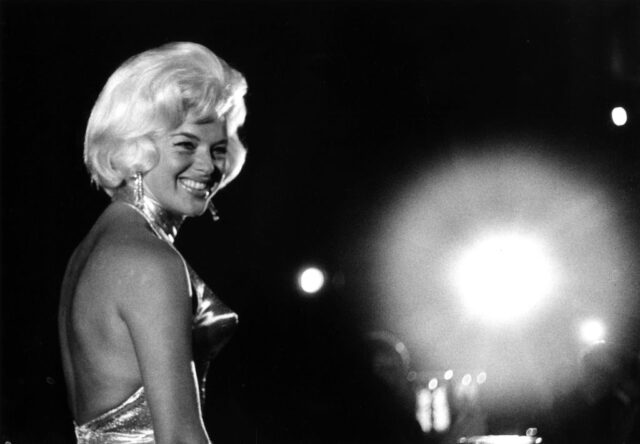
Born in Swindon, England in 1931, Diana Fluck, as she was known, had her attention grabbed by the big screen from an early age. She was the youngest ever student at the London Academy of Music and Dramatic Art. She was 14, yet everyone believed she was older. It helped that she’d lied about how old she was to get an offer from the school.
It was in 1947 that she appeared in her first film, The Shop at Sly Corner, and she continued to act in smaller productions until her breakthrough part in 1949’s Diamond City, a period drama set in 19th-century South Africa. While a commercial flop, it brought the actor’s face to the masses, affording her several opportunities, including Worm’s Eye View (1951), one of the most popular films of the year in the United Kingdom.
Other notable performances during the 1950s included that of a convicted murderess in 1956’s Yield To The Night and a hostess in Tread Softly Stranger two years later. These demonstrated that “she was not just a pretty face and body, but an actress to be reckoned with.”
It was only a matter of time before Dors had a shot at Hollywood. Publicists were keen to put her in the Marilyn Monroe bracket, although her talents were underestimated.
Diana Dors’ troubled marriage to Dennis Hamilton
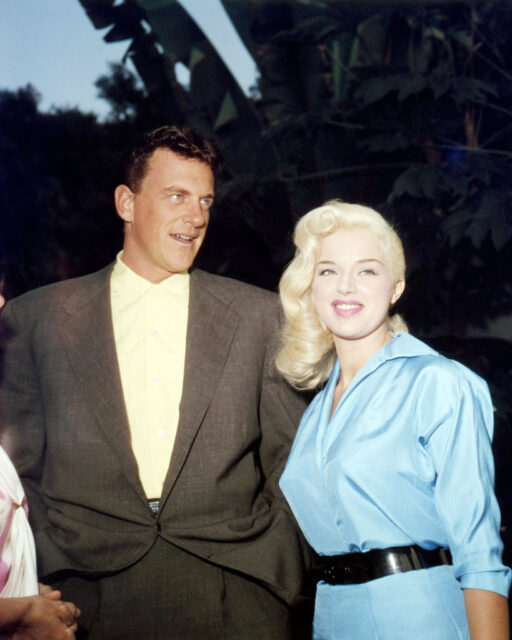
When Mike Wallace asked Diana Dors about starting “in the same way that Marilyn Monroe” did, her response was rapid. “No, I didn’t, Mike,” she said. “I was given a part in a film. And by the time I was fifteen I was under contract to the Rank Organization, and then I had made something like 23 pictures by the time I was seventeen.”
Unfortunately for Dors, she went to Tinseltown with her then-husband, Dennis Hamilton, whom she’d married in 1951. An actor-turned-salesman, he was an exploitative and violent man who took control of her business affairs. A 2010 Express article quoted her as saying:
“I never fell in love with Dennis nor loved him in the truest sense of the word. Rather I was the fly caught in the spider’s web. […] I was married to a virtual stranger. It was so sickening that I began to hate Dennis almost as much as I hated myself for being so stupid.”
Hamilton reportedly involved her in sex parties and quashed opportunities that could have made her a name across the pond. Her association with Hollywood came to a disastrous end during a party thrown for her by Hamilton. The trouble started when “Diana and Hamilton plus Diana’s US agent and a dress designer were posing for photos by the pool.”
Apparently, “pressmen surged forward, toppling all four into the pool.” Hamilton’s reaction was ruthless. He “emerged furious, punched the nearest photographer to the ground and kicked him in the head until he lost consciousness.” This scandal created a flurry from which Dors felt she needed to get away.
Return to the United Kingdom
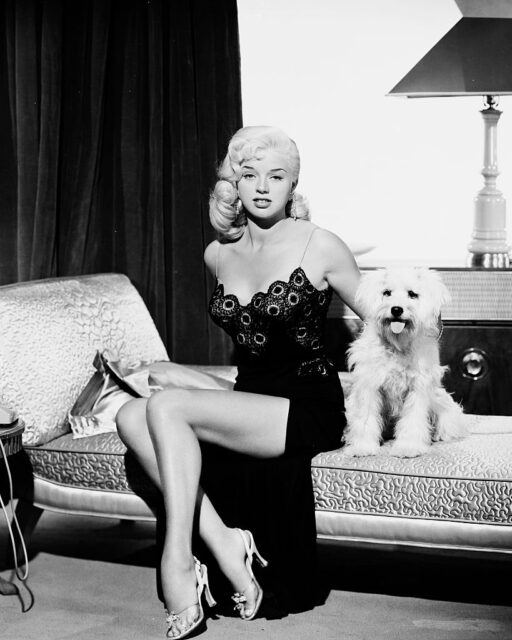
Diana Dors returned to the United Kingdom and resumed her acting career, starring in The Long Haul (1957). She split with Dennis Hamilton, although the union left her struggling, financially. She continued to act and received positive reviews, and earned sidelines in cabaret and much later as a TV agony aunt.
Arguably, the comparisons with Marilyn Monroe ended as she grew older, though the pair shared an emotional connection of a kind only experienced by the famous and adored.
“You see, we’re really talking about two different people: We are talking about the Diana Dors that the world knows, as a kind of publicity, film actress, who only faces things, likes to go out, and be seen at premieres and nightclubs,” she told Mike Wallace. “But the other Diana Dors, which is the one that I am inside, really doesn’t like any of these things at all.”
Diana Dors’ later life and death
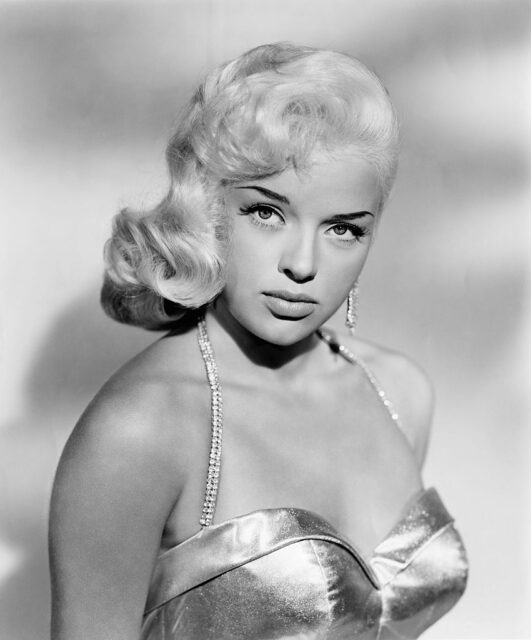
Behind the scenes, Diana Dors went on to marry Richard Dawson between 1959-66, with the pair living in the United States. She continued to appear in films, and returned to the United Kingdom following her divorce. In 1968, she got hitched to actor Alan Lake, with her career by this point largely consisting of television and supporting roles.
Tragically, Dors was diagnosed with ovarian cancer in the early 1980s and passed away in ’84, at the age of 52. Her final movie role was in the acclaimed drama Steaming (1985), directed by Joseph Losey and starring Vanessa Redgrave and Sarah Miles. It was a welcome highlight for her fans, but her personal life ended on a devastating note.
More from us: Rare Behind-the-Scenes Photos From Our Favorite Classic Movies
Alan Lake took his own life a few months after Dors’ death, taking with him the whereabouts of her fortune, which was said to be in the region of £2 million. She supplied the family with a cryptic code, but only Lake knew how to unlock it, leading to a mystery that continues to this day.
